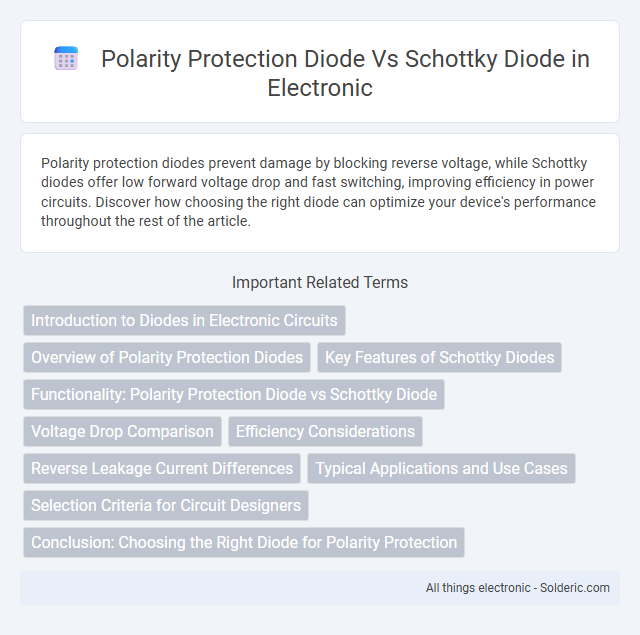Polarity protection diodes prevent damage by blocking reverse voltage, while Schottky diodes offer low forward voltage drop and fast switching, improving efficiency in power circuits. Discover how choosing the right diode can optimize your device's performance throughout the rest of the article.
Comparison Table
| Feature | Polarity Protection Diode | Schottky Diode |
|---|---|---|
| Purpose | Protects circuits from reverse polarity damage | Allows fast switching and low forward voltage drop |
| Forward Voltage Drop | Typically 0.7V (Silicon diode) | Typically 0.2 - 0.3V |
| Switching Speed | Moderate (limited by PN junction) | Very fast (due to metal-semiconductor junction) |
| Leakage Current | Low to moderate | Higher leakage current compared to silicon diodes |
| Use Case | Reverse polarity protection in circuits, power inputs | High-frequency rectification, voltage clamping, RF applications |
| Reverse Recovery Time | Longer (microseconds) | Very short (nanoseconds) |
| Cost | Generally low | Moderate to high |
Introduction to Diodes in Electronic Circuits
Diodes serve as critical components in electronic circuits by controlling the direction of current flow, with polarity protection diodes ensuring devices are safeguarded against reverse voltage damage. Schottky diodes offer low forward voltage drop and fast switching speeds, making them ideal for high-efficiency power applications. Understanding the distinct characteristics of polarity protection and Schottky diodes allows you to optimize circuit reliability and performance effectively.
Overview of Polarity Protection Diodes
Polarity protection diodes are designed to prevent damage to electronic circuits by blocking reverse voltage, ensuring current flows only in the intended direction. Compared to Schottky diodes, which offer low forward voltage drop and fast switching speeds, polarity protection diodes prioritize safeguarding circuit components from incorrect battery or power supply connections. Typical implementations include standard silicon diodes and specialized polarity protection devices, each optimized for different voltage, current, and power efficiency requirements.
Key Features of Schottky Diodes
Schottky diodes feature low forward voltage drop, typically between 0.15 to 0.45 volts, enhancing power efficiency and reducing heat generation compared to polarity protection diodes. They exhibit fast switching speeds due to minimal charge storage, making them ideal for high-frequency applications and rectification in power supplies. Their low forward voltage and rapid response improve overall circuit performance, especially in switching regulators and voltage clamping scenarios.
Functionality: Polarity Protection Diode vs Schottky Diode
A polarity protection diode prevents damage by blocking reverse polarity voltage, ensuring current flows only in the correct direction to safeguard sensitive circuits. Schottky diodes feature a low forward voltage drop and fast switching speed, optimizing efficiency in power applications but are less focused on reverse polarity protection. Unlike standard polarity protection diodes, Schottky diodes excel in minimizing power loss and heat generation during forward conduction.
Voltage Drop Comparison
Polarity protection diodes, typically standard silicon diodes, exhibit a voltage drop around 0.7 volts, which can lead to significant power loss in low-voltage circuits. Schottky diodes, manufactured with a metal-semiconductor junction, have a much lower forward voltage drop ranging from 0.15 to 0.45 volts, enhancing efficiency in power-sensitive applications. This reduced voltage drop minimizes heat dissipation and improves overall circuit performance where low forward voltage is critical.
Efficiency Considerations
Polarity protection diodes, typically standard silicon diodes, exhibit higher forward voltage drops around 0.7V, leading to greater power loss and reduced efficiency in circuits. Schottky diodes offer significantly lower forward voltage drops, typically between 0.2V to 0.4V, which minimizes power dissipation and improves overall energy efficiency. The lower forward voltage of Schottky diodes makes them preferable for applications requiring high efficiency and low heat generation.
Reverse Leakage Current Differences
Polarity protection diodes typically have higher reverse leakage current compared to Schottky diodes, which are known for their low reverse leakage due to their metal-semiconductor junction design. Schottky diodes minimize power loss and improve efficiency in circuits by reducing leakage current, especially in high-frequency applications. Your choice between the two should consider the trade-off between leakage current and forward voltage drop for optimal circuit protection.
Typical Applications and Use Cases
Polarity protection diodes are commonly used in power supply circuits to prevent damage from incorrect battery or power input connections by blocking reverse current. Schottky diodes excel in high-speed switching applications such as power rectification in voltage clamping, solar panel systems, and low-voltage, high-efficiency power converters due to their low forward voltage drop and fast recovery time. Both diodes are key in ensuring circuit reliability, with polarity protection diodes prioritizing reverse polarity prevention and Schottky diodes optimizing efficiency in high-frequency and low-voltage environments.
Selection Criteria for Circuit Designers
When selecting between a polarity protection diode and a Schottky diode, circuit designers prioritize factors such as forward voltage drop, reverse leakage current, and switching speed. Polarity protection diodes are essential for preventing damage from incorrect power supply connections, typically prioritizing robustness over voltage drop. Schottky diodes, favored for their low forward voltage and fast switching characteristics, are ideal for efficiency-critical applications and minimizing power loss in DC-DC converters and power supplies.
Conclusion: Choosing the Right Diode for Polarity Protection
Polarity protection diodes and Schottky diodes serve different purposes based on voltage drop and switching speed requirements. Polarity protection diodes commonly use standard silicon diodes, offering reliable reverse voltage protection but with higher forward voltage drops, typically around 0.7V. Schottky diodes provide low forward voltage (0.2-0.3V) and fast switching characteristics, making them ideal for efficient polarity protection in low-voltage and high-frequency circuits.
Polarity protection diode vs Schottky diode Infographic

 solderic.com
solderic.com